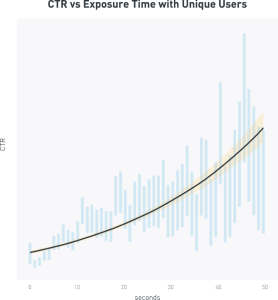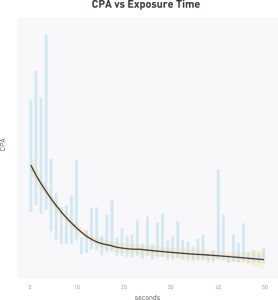Exposure Time: A New Standard for Measuring Digital Effectiveness?
by Lindsay Rowntree on 1st Feb 2016 in News


Arguments abound about the best way to measure digital campaign effectiveness; but no industry standard exists. ExchangeWire talked to Tim Geenen (pictured below), director of strategy and innovation, Bannerconnect, about a study they carried out, which shows that exposure time could be the go-to metric the industry has been crying out for.
ExchangeWire: Where is the industry currently going wrong in measuring the effectiveness of digital campaigns?
Tim Geenen: Attribution is no easy feat for today’s digital marketers and advertisers. With search, display, and social all measured separately across various formats, channels, and devices, there’s little to no consistency in measuring digital campaigns. It makes intelligent, data-driven attribution almost impossible for digital marketing and advertising professionals, who end up with a tonne of data points that don’t connect, and give no indication of the overall effectiveness of online efforts.
Consumer behaviour knows many variables. Understanding these variables is vital for optimising campaign performance. The key to giving credit where credit is due is by using results from cooperative game theory, and in particular, calculation of the Shapley Value. The Shapley Value calculates the value assigned to a player for their contribution to winning the game. This is a useful theory to apply to attribution by helping answer the question of which touchpoints are helping to further the campaign.
Digital advertisers are missing opportunities by focusing on vague, traditional metrics (such as CTR, CPA) and misplacing budgets as a result. It might make sense that media buyers pursue whichever type of advertising yields the most engagement – whether through conversions, clicks or actions – but this is a superficial view of advertising. Getting to the point of sale is a process; marketing is about getting people excited about your product, which usually happens after several unique engagements. However, as it stands, currencies and metrics are biased towards the final stages of advertising, ignoring the necessary higher funnel foundations that build successful campaigns. This short-sighted view lures only the most impulsive of consumers.
Digital advertising needs a new leading metric for display advertising; one that shows effect and correlation between channels and doesn’t play favourites with methods focused on lower funnel activity. Programmatic and data play an important role in getting results, but getting them right is crucial.
Does ad viewability have a role to play in measuring effective digital campaigns?
Measuring viewability is a positive development, but it’s not the disruptor digital marketers need for attribution. Whether or not an ad is in-view fails to give a good indication of the effectiveness of a campaign or consumer engagement. Evolving the in-view question into for how long an ad is in-view – the exposure time – gives a much fuller understanding of campaign performance and consumer engagement. The exposure time is a fitting metric to calculate the Shapley value for the different domains. For example, a domain that 'bombs' non-viewable impressions in an effort to get the last-click attribution will fail when measured against this new metric. We hypothesised that measuring and optimising campaigns on exposure time can achieve better results on traditional metrics (CTR, CPA) and increase engagement; so we embarked upon a research project to prove just that.
What did your research into optimisation against exposure time reveal?
We collected data from half a billion impressions in H1 2015, from different brands in the Netherlands, using standard IAB formats over a 60-day period. The objective behind the research project, 20/20 (referring to perfect vision), was to find out if consumer behaviour could be influenced by creating a leading actionable, and time-based metric. Rather than focusing simply on conversion, 20/20 focuses on capturing an audience. The 20/20 research found the two are deeply connected.
The research looked at the relationship between exposure time and performance, taking clicks, cost, and conversions into account. We found that as exposure time increases, so does CTR. The first 10 seconds see an approximate 20% increase, with a maximum of around 30% after 30 seconds. However, it was uncertain whether this is caused by exposure time, or just increasing contact frequencies, which were included in the initial data analysis.

Source: Bannerconnect
It seems the optimum contact frequency is around 10. A higher contact frequency is a confounding factor in this analysis, as seeing an impression once for 10 seconds is clearly different from seeing 100 identical impressions for 0.1 seconds each.
The data was analysed again, this time focusing solely on unique contact moments to exclude the influence of contact frequency.
Here, there is a much clearer connection between exposure time and performance. Unique contacts saw a much more pronounced increase: the CTR increases by 30% during the first 10 seconds, and this rises to over 200% at 30 seconds exposure time. There is also a clear relationship between exposure time and CPA, with CPA being positively influenced by an extended exposure time.

Source: Bannerconnect

Source: Bannerconnect
Exposure time directly influences the efficacy of a campaign. In-view impressions with short exposure time contribute less to the success of a campaign than those with a longer exposure time. The CPA decreases by around 70% during the first 10 seconds. There is insufficient data to pull further conclusions from here, but the decline appears to continue. Using exposure time as a metric in this analysis offers opportunities for optimisation.
Exposure time is an evolved metric that gives a more in-depth overview of campaign performance and can increase the value of digital display advertising. Bannerconnect’s Project 20/20 found that standard IAB- and 3MS-compatible placements, with a short exposure time, achieved lower levels of engagement, such as clicks. Therefore, measuring whether or not an ad is in-view is superficial; exposure time is more pertinent, and a much better way to properly attribute value. The first 20-30 seconds always shows the biggest jump in engagement, after which the data loses statistical significance and fewer conclusions can be drawn. Finding and optimising towards the perfect exposure time will create higher levels of engagement and increase campaign performance. Exposure time is the metric needed to disrupt the digital advertising industry, helping marketers make more informed, data-driven decisions for attribution.
The initial results look compelling, but can optimisation against exposure time actually become a reality for publishers and advertisers?
While exposure time is still in its early stages, we have big plans to make this new metric an industry standard and believe other publishers will quickly follow suit. One of our core clients has created best practices on exposure time optimisation directly off the back of our study, citing it as a clear direction on how to drive ROI with a differentiated story, which their advertisers are keen to onboard. Currently exposure time is not a standard or simple metric to optimise against, but with the developments in platform support for viewability, we are confident that exposure time will be a logical next step, and we can be at the forefront of pushing for this as an industry standard.
What are the next steps in the industry for developing this into a standardised metric?
For us, while the research has so far focused on display advertising, further research will be conducted to evaluate the effect of exposure time on video and mobile in-app advertising. Full integration and comparison of 20/20 results with game theory for attribution is also on the cards.
We are working closely with AppNexus to investigate the possibilities of applying insights to customised algorithms. AppNexus are similarly keen to see what opportunities exposure time will open up, saying that our 20/20 project illustrated the possibility for marketers to build their own currency for evaluating their brand advertising campaigns, choosing the data and metrics that will best help them determine the optimal mix of display and other channels for their specific campaign. It is definitely an exciting time for digital measurability.
attributionDataDigital MarketingDisplayPerformance







Follow ExchangeWire